The Pace-Feeling Puzzle: Running's Dynamic Duo
The Pace-Feeling Puzzle: Running's Dynamic Duo
Ever wondered why pacing is such a big deal in running? Well, it's all about finishing the race as fast as possible, right? But there's more to it than just speed!

Pace vs. Perception: The Great Debate
Runners, both elite and casual, have been trying to crack the code of pacing for years. It's not just about how fast you go, but how you feel while doing it. Sometimes, you think you're flying, but your watch says otherwise. It's a tricky balance!
Research Revelations: The Science of Pacing
Recent studies have dived deep into this pace-feeling conundrum. They've looked at everything from age and gender to psychological factors. Turns out, faster marathoners keep a steady pace, while slower ones might struggle a bit more. And guess what? In short sprints, going all out is the way to go, but for longer races, it's all about strategy.
Mind Over Matter: The Mental Game
Pacing isn't just physical; it's a mental game too. Your brain plays a huge role in how you perceive your effort. Ever noticed how music can pump you up? That's because the tempo can sync with your body's rhythm, making you feel less tired and more energized.
Consistency is Key: The Pacing Strategy
Keeping a consistent pace is crucial for a great performance. Some runners speed up towards the end based on how they feel. It's all about balancing your physical capabilities with your mental perceptions. And yes, age and experience matter too. Older runners tend to have smaller pace changes compared to younger ones.
The Gender Factor: Pacing Differences
Men and women approach pacing differently. Men might overestimate their abilities and start too fast, while women tend to be more conservative. This can lead to different challenges towards the end of the race.
The Role of Technology: Gadgets and Gizmos
In today's tech-savvy world, runners have a plethora of gadgets to help them with pacing. From smartwatches to apps, technology can provide real-time feedback on your pace and effort. But remember, while gadgets are helpful, they can't replace the importance of listening to your body.
Training Tips: Mastering the Art of Pacing
To master pacing, it's essential to train both your body and mind. Incorporate interval training, tempo runs, and long runs into your routine. Practice running at different paces and pay attention to how your body feels. Over time, you'll develop a better sense of your optimal pace.
Conclusion: The Pacing Puzzle
Pacing is a complex puzzle influenced by many factors. From age and gender to mental strategies and external cues, everything plays a part. As researchers continue to explore this topic, runners and running coaches can use these insights to optimize training and performance. So, next time you hit the track, remember, it's not just about speed; it's about how you feel while running!
Running with SSISA
Think Running. Think the Sports Science Institute of South Africa.
We offer runners advanced sports science research and expert health professionals to enhance performance and address injuries. To find out more about the running products and services we offer, click on the link below:
References:
-
Menting SGP, Hendry DT, Schiphof-Godart L, Elferink-Gemser MT, Hettinga FJ. Optimal Development of Youth Athletes Toward Elite Athletic Performance: How to Coach Their Motivation, Plan Exercise Training, and Pace the Race. Front Sports Act Living. 2019 Aug 20;1.
-
Smyth B. Fast starters and slow finishers: A large-scale data analysis of pacing at the beginning and end of the marathon for recreational runners. Journal of Sports Analytics. 2018 Apr 24;4(3):229–42.
-
Renfree A, Casado A. Athletic races represent complex systems, and pacing behavior should be viewed as an emergent phenomenon. Vol. 9, Frontiers in Physiology. Frontiers Media S.A.; 2018.
-
Berndsen J, Lawlor A, Smyth B. Exploring the wall in marathon running. Journal of Sports Analytics. 2020 Jun 9;6(3):173–86.
-
Inoue A, Santos TM, Hettinga FJ, Alves D de S, Viana BF, Terra B de S, et al. The Impact of Sex and Performance Level on Pacing Behavior in a 24-h Ultramarathon. Front Sports Act Living. 2019 Nov 6;1.
-
Nikolaidis PT, Knechtle B. Effect of age and performance on pacing of marathon runners. Open Access J Sports Med. 2017 Aug;Volume 8:171–80.
-
Wu J, Zhang L, Yang H, Lu C, Jiang L, Chen Y. The Effect of Music Tempo on Fatigue Perception at Different Exercise Intensities. Int J Environ Res Public Health. 2022 Apr 1;19(7).
-
de Leeuw AW, Meerhoff LA, Knobbe A. Effects of Pacing Properties on Performance in Long-Distance Running. Big Data. 2018;6(4):248–61.
-
Díaz JJ, Fernández-Ozcorta EJ, Santos-Concejero J. The influence of pacing strategy on marathon world records. Eur J Sport Sci. 2018 Jul 3;18(6):781–6.
-
Smyth B. How recreational marathon runners hit the wall: A large-scale data analysis of late-race pacing collapse in the marathon. PLoS One. 2021 May 1;16(5 May).
-
Cuk I, Nikolaidis PT, Villiger E, Knechtle B, Stankevičius E. medicina Pacing in Long-Distance Running: Sex and Age Differences in 10-km Race and Marathon. 2021; Available from: https://doi.org/10.3390/medicina


